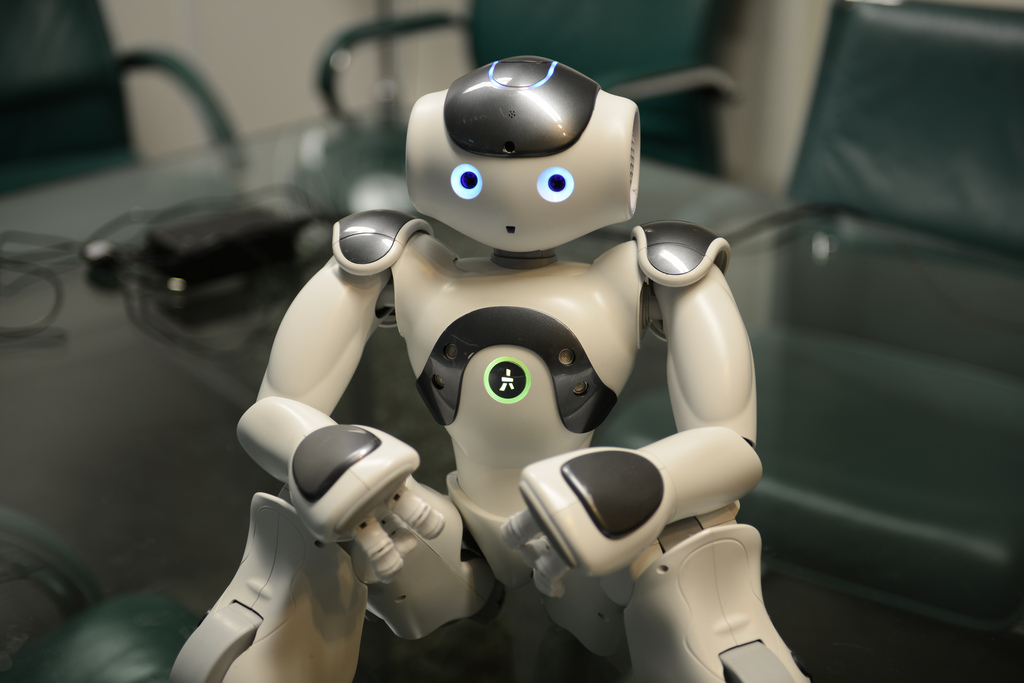Photo by Chris Kendig
Meet NAO.
NAO came to Temple University about three years ago, when Li Bai and Carole Tucker, researchers from the Colleges of Engineering and Public Health, and, joined Heidi Grunwald, director of Temple’s Institute for Survey Research, to study robotics and surveys.
The team wanted to explore a big idea: What if NAO, this cute, two-foot tall, human-ish robot, could be programmed to give health surveys to children on the autism spectrum? Could they create a system to collect patient-reported outcomes in this tough-to-survey population?
Potentially, this research could solve a number of difficult problems. Currently, its parents fill out surveys on behalf of their kids. Researchers would prefer patient-reported outcomes. It’s much more accurate than information filtered through a third party, such as a parent. “Kids with autism may be willing to say they are depressed, but not in front of their mother,” says Tucker. When a one-foot-tall robot with a cute robotic voice such as NAO is asking questions instead of a human clinician, researchers might get reliable patient-reported outcomes in a way they have not been able to in the past.
The team’s research would also include another stream of valuable information: para-data. The camera inside the robot would “watch” the subject as NAO asked the survey questions. Additionally, via the sensor the subject wears (a Microsoft wristband), researchers can monitor things like facial expression, heart rate, and body motion. This para-data is a rich vein of knowledge, particularly when combined with the survey questions, response time, and answers.
If the subject pauses an extra long time when a certain question is asked, the NAO can play a game (like rock, paper, scissors), take a break, or give a high five to reduce anxiety. This is one way that the robot uses para-data to adapt to a child’s answers. The para-data also helps the researchers better understand survey responses. “For example, we can tell if a particular question made a subject nervous and then down-weight the answer, or not count it,” explains Grunwald.
“The robot’s face is much less complex than a human face and human facial expressions,” says Tucker. That makes it much less overwhelming for a young person on the autism spectrum who may find it challenging to read people’s faces and maintain eye contact.
Their project received funding through the Office for the Vice President of Research’s Targeted Grant Program at Temple University, with matching funds from all three represented schools.
Planning the research has been an iterative process. On the computer science side, Bai and his engineering students have been exploring the feasibility of using NAO this way. Bai and the students have been answering questions like, “What features would be nice? How can we use sensors to pull in data and incorporate the Microsoft band?” They have iterated and refined the data architecture, a database where the data are meshed together so that the robot can read all of the survey response data–coupled with the para-data (sensor data).
Meanwhile, the questionnaire and para-data collection process have been tested on different groups, starting with older kids not on the autism spectrum. As trial subjects, children aged 10 and up can provide specific, meaningful feedback on interacting with NAO. More recently, a community event brought a group of children on the autism spectrum to campus, and the team had an opportunity to see NAO interact with the intended study subjects. Going forward, they have the kind of pilot data that can win the funding to drive this effort forward.
This work can benefit groups beyond younger people on the autism spectrum. Any time data reported directly from a patient may be skewed or inaccurate—such as dementia patients, for example—the survey methods used in this work could prove enormously helpful to clinicians.
“With future improvement in this type of research, I think we will see more robotic diagnostic platforms that will be developed. One of the functionalities will be surveys of the patients about their health conditions. It could be particularly important for people who can not find a good hospital in their neighborhood,” says Bai.
Practical applications of this work in the future aren’t limited to the realms of research and medicine by any means. “Artificial intelligence and robotics will be the next technology push to drive the economy of our country, There will be countless business world applications—such as personal robotic assistants (such as the iPhone’s Siri) or self-driving cars,” says Bai. He believes that the technology in this project will fuel innovations across all sectors of the economy in the years to come.
This story was originally published in On the Verge, the Fox School’s flagship research magazine. For more stories, visit www.fox.temple.edu/ontheverge.

